The potential of DeFi is enormous.
What is DeFi?
Decentralized finance protocols have seen staggering growth over the last two years, with 2020 hitting the milestone figure of over $12 billion in total locked assets. DeFi protocols, or autonomous programs, were built to solve pain points in the traditional finance industry. Decentralized lending allows users to borrow without going through a flawed banking system that many have become disillusioned with over the last decade. Peer-to-peer lending is an unrefined but promising glimpse into a future where people can borrow money without worrying about a banking collapse, fraud, or excessive fees for basic tasks.
With over 50% of the world’s population lacking access to a bank account, the nascent industry could be on the cusp of tapping into a huge financial market, and venture capital firms are paying attention. The industry now holds over $9 billion in locked assets, and various projects have amassed hundreds of millions of dollars in funding. These projects are working on solutions for lending, for encouraging cryptocurrency adoption by creating liquidity between multiple blockchains, and for creating on-chain assets such as stocks and shares.
However, the space is still in development and has many potential risk factors. In this piece, we’ll discuss some of the major projects in the space, their purpose, their financial backing, and their potential weak points.
Uniswap
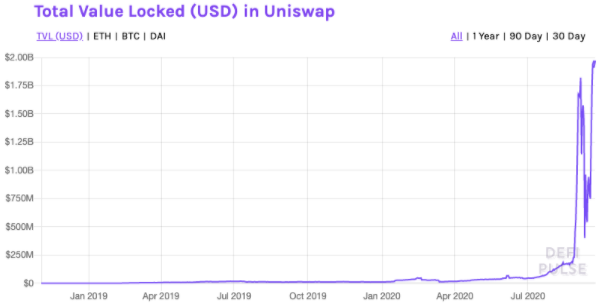
Source: DeFi Pulse
While 2020 has been the biggest year for Uniswap, the company initially came about in late 2018. It was founded by Hayden Adams in New York, who found himself seeking an entirely new career route the year prior when he was laid off from his job as a mechanical engineer, the first position he held following his college graduation. He told a friend at the Ethereum Foundation about his plight, and it was this friend, a young man named Karl Floersch, who got him involved in the growing field of smart contract development, which at the time, was relatively new to the crypto space and the world of decentralized finance.
In his first five months of unemployment, Adams found himself working on real-time projects based on the Ethereum network, a technological system that fascinated him. However, he was disappointed to discover that very few of these projects fully embraced the notions that Ethereum was built on. Things like censorship resistance, decentralization, permissionless transactions and security. This is what inspired Adams to create Uniswap, an enterprise that he said would embody everything that Ethereum and crypto stood for.
By January of next year, Adams had reached out to several acquaintances who had experience working with major tech companies like Google and Microsoft. Together, they built a small demo version of what would become Uniswap. Over the next few months, Adams would find himself traveling to crypto events in regions such as Canada and South Korea, where he would meet Ethereum founder Vitalik Buterin. Intrigued by his project, Buterin told Adams to apply for an Ethereum grant and rewrite Uniswap in Vyper.
Adams would later receive the grant and would spend time working at the offices of crypto companies like Maker and Balance, which would allow him to garner the technical knowledge he needed to create a mainnet launch for Uniswap. It was then launched in late 2018 at Devcon in Czechia’s capital city of Prague that year. Presently, the company offers more than 16,000 token pairs and Uniswap’s total liquidity is just shy of $3 billion.
How It Works
Uniswap is a decentralized exchange built on Ethereum’s smart contracting protocol to allow anyone to swap ERC-20 tokens directly from their Ethereum wallet. In September of this year, the company introduced users to UNI, the platform’s digital token, of which roughly 60 percent has been allocated to Uniswap users.
Over the past two years, Uniswap has overseen roughly $20 billion in trades and has been integrated into hundreds of interfaces, making it one of the most prominent and successful DeFi platforms in existence. On average, daily trades often exceed $220 million.
Some of the things leading to Uniswap’s present levels of success and adoption include the fact that it does not rely on any fees to garner income. There are no fees for those who engage in transactions on the platform, and there are no middlemen required to push transactions through. Thus, the company is fully decentralized and all trades are permissionless.
The company’s big claim to fame is its integration of what’s known as the “Constant Product Market Maker Model,” which allows users to fund any token with equal values of both Ethereum and the ERC-20 token they’re looking to trade.
Yield Farming
Any ERC-20 token can be traded and listed on the platform. There is a liquidity pool for virtually every token the company lists. These tokens can be traded by anyone, and all users can contribute to the liquidity pools of these tokens while earning part of a 0.3% provider fee.
Should Ethereum or any other ERC-20 token be contributed to the platform’s liquidity pool, the contributor garners what’s known as a pool token. This token can then be traded or moved around at the owner’s will. Should this money ever be reclaimed, it is immediately burned and taken out of commission.
Governance
The company employs its own native cryptocurrency known as the UNI token. Simply holding this token in one’s digital wallet allows them to have a say in how the company operates. It also gives them a vote in all upcoming elections or when changes are suggested to the platform.
All UNI holders are required to ensure all governance decisions are upheld and remain within the bounds of set laws. To do this, a fee switch is used by UNI holders to vote on any tokens they’re looking to collect fees on. All community members in charge of governance are advised to speak with legal professionals before they decide to vote on any change or alteration.
The Uniswap team has no say in auditing or other legal matters, though they can occasionally delegate votes. Other than this, however, it is primarily the Uniswap community that has control over how the platform operates. If someone is looking to submit a governance proposal, they must pay approximately 1% of their overall UNI tokens. From there, anyone looking to vote “yes” on a submitted proposal must pay 4% of their UNI supply.
Funding
Uniswap has announced that it is looking to shell out approximately one billion UNI tokens through 2024. Roughly 60% of these tokens will be given to community members, while just over 21% will be provided to employees of the company. The remaining tokens will be offered to both advisors and investors of Uniswap. Just last September, nearly $2 billion in Ethereum was being stored on the Uniswap platform.
Yearn Finance
Yearn Finance, or YFI, was founded by South African entrepreneur Andre Cronje earlier in the year, who was initially part of the iEarn project up through last February. This project would produce so few results that Cronje would exit the program and later vowed to step away from the DeFi space for good, referring to it as a “toxic” environment. However, he would return in the late summer and rebrand iEarn as the YFI platform crypto traders know and love today.
As Yearn Finance, the company’s finances would reverse themselves from when it initially operated under the iEarn brand. As of late September of this year, Yearn’s total locked in value would exceed $1 billion.
Cronje’s technical expertise comes from his time spent with smart contract companies CryptoBriefing and Fantom, where he would oversee the release of crypto-related news media and the establishment of digital token offerings.
Prior to his work in the DeFi space, Cronje initially sought to study law, but later changed to computer science and completed a program in about half a year. He went into fintech and later gained fame and recognition for his code reviews before establishing himself as the founder of Yearn Finance.
How It Works
Yearn Finance is a string of DeFi-focused protocols that are currently undergoing beta testing. While the company’s website warns that traders should engage at their own risk, the company is looking to give users access to high, “risk-adjusted” returns on Ethereum-based tokens.
The goal of the company is to simplify the DeFi space for new investors or individuals who may not have lengthy technical backgrounds. It also seeks to provide a more easy-going environment for investors who may not be as committed to DeFi and crypto as experienced traders. The company’s website discusses yield-farming robots that are fully developed by community members. They allow one to autonomously move one’s digital assets between lenders to potentially boost one’s profits.
Governance
What makes Yearn Finance important is that it is fully decentralized, meaning that those who take part in its operations and services are not subject to the laws of financial institutions and can take part in the decision-making processes of the company. No alterations occur on Yearn Finance without say-so. All changes happen on-chain and take place only after the community has voted in favor of it.
Control of Yearn Finance has been distributed to about nine separate people that are now in charge of the company’s multi-signature wallet. For any changes to occur, they must be approved by six of these nine individuals.
The company’s governance token is known as YFI. The token is given primarily to customers that provide some level of liquidity with their yTokens. There are no pre-mine or pre-sale events, and no funds are allocated to the Yearn Finance team, bringing a whole new level of decentralization to the company.
Yield Farming
The company utilizes many lending services including Compound, Dydx and Fulcrum, thereby optimizing lending options to ensure customers always get the most rewards from their money. This is arguably why adoption has grown so steadily in the last several months. The company works by taking all currencies deposited by investors and converting them into what are known as yTokens. These funds are then regularly rebalanced to make sure customers always have access to the arena’s most profitable lending services.
At the time of writing, one can deposit and earn interest on DAI, USDC, USDT, sUSD and TUSD. Over the past few months, the YFI token has surged more than 300%.
Funding
It is reported that over $600 million in digital assets have made their way into Yearn Finance’s liquidity pool. Overall, Yearn Finance has a total supply of 30,000 tokens, which is relatively scarce when compared with most other altcoin supplies.
All tokens have been distributed to users that now hold a stake in the governance of the YFI platform. They use these tokens to vote on protocol changes and cash in on processing fees, though according to YFI documents, further coins can be minted. In September, at a time when bitcoin was losing $2,000 off its price, the YFI token hit its all-time high of more than $40,000 per token, making it the first altcoin in the history of crypto to surpass BTC.
Project Serum
As one of the newer DeFi protocols in existence, Project Serum was founded in August of this year by Sam Bankman-Fried and several members of the FTX Exchange (Sam’s alternate company). Sam initially established FTX in 2019. He is also the CEO of Alameda Research, a crypto liquidity provider, and a top trader with Jane Street.
Project Serum began when Sam and many of his counterparts at FTX looked into the prospects of developing a new derivatives exchange. At the time, Ethereum, despite its popularity and surging presence in the DeFi space, proved incapable of handling the major features Sam and his team members were looking to implement. They thus turned their attention to Solana (SOL), which they felt was a stronger and more efficient blockchain.
Getting Project Serum off the ground required partnerships and the assistance of many leading cryptocurrency enterprises including TomoChain, Compound, Multicoin Capital and Kyber Network. In addition, several advisors were brought on board such as Robert Leshner and Calvin Liu. The former is the founder of Compound, while the latter is the strategy lead.
How It Works
Project Serum is the crypto world’s latest decentralized exchange (DEX). Unlike other protocols involved in decentralized finance, Project Serum is built utilizing a blockchain unrelated to Ethereum. Serum was in testing up through August of this year, but has since been unveiled to the public for trade use.
One of the unique things about Project Serum is that it is fully permissionless, according to its website, and it is looking to solve many of the centralization problems that often appear in the world of DeFi. Traders are free to use the exchange at their own will. In addition, the exchange boasts low fees and fast trades, with transactions allegedly taking mere seconds to complete.
Some of the reasons for Project Serum’s adoption is that it runs on a blockchain that is completely compatible with both Bitcoin and Ethereum, something that’s rarely seen in the DeFi space. This gives Project Serum a huge advantage in that it allows traders to engage in transactions involving currencies other than ERC-20 tokens.
Furthermore, the company does not employ know your customer (KYC) protocols, meaning every person participating in the project remains fully anonymous. All these elements combined create an environment of trustless cross-chain trading.
Governance
Users that hold $SRM or SRM token, the platform’s native cryptocurrency, can take part in the governance system through staking, nodes and voting protocols. Nodes work to optimize Serum’s platform to ensure it remains efficient and in top shape for all users. They also are responsible for managing the company’s insurance fund and for submitting blockchain histories.
Users can start a Serum node by staking ten million SRM and one MegaSerum (MSRM). Nodes are often used to suggest changes to Serum’s present rules. To suggest a change, a community member must submit 50,000 worth of SRM. This is taken from the node’s asset pool.
Should the change be made, the money is not returned. Otherwise, if the alteration fails to garner approval, the money is burned or removed from commission. 60% of the total staked SRM is required if the change is to be incorporated.
Utility
The SRM token is often used to pay for fees on the company’s platform. Just by holding SRM in their online accounts, customers can experience 50% lesser fees on all future trades, making the company similar with Binance, the world’s largest and most popular cryptocurrency exchange, and how it utilizes its native BNB token. Users who hold SRM can also participate in the platform’s many token burns and receive portions of any related fees.
Node operators garner SRM staking rewards depending on how well their nodes perform. If they don’t have enough SRM tokens in their wallets to host their own nodes, they can stake towards another user’s node and thus rake in small portions of the rewards in relation to that node.
Funding
Distribution of SRM tokens is as follows: approximately 20% of the total goes to team members and advisors of Project Serum. 22% of the tokens go to project contributors, while 27% is locked away in a partner and collaborator fund. Another 27% goes to an ecosystem incentive fund, while the remaining 4% of tokens go to locked seed and auction purchasers.
Sushi
Sushi is one of the newest DeFi platforms to come about, first establishing itself on August 26 of this year through a hard fork of Uniswap. The venture’s founder, much like Satoshi Nakamoto of bitcoin fame, operates under a pseudonym. At the time of writing, he (or she) is known simply as “Chef Nomi.”
Up through late August, the company’s smart contracts hadn’t been audited, though Nomi later mentioned in a tweet that Quantstamp, a blockchain security protocol, was looking to conduct the first audit. It was later revealed that Quantstamp only did a review of the company, while PeckShield performed the audit.
How It Works
Sushi, otherwise known as SushiSwap, is a DeFi protocol that despite being brand new to the DeFi arena, has already moved beyond the $1 billion mark in total value. Sushi is the result of a Uniswap fork. The company is swiftly garnering value and liquidity from Uniswap. Thus far, more than 75% of its total assets have been aggregated, according to data from asset monitor Zippo.
Some of the main reasons for Sushi’s popularity and adoption include the company’s “community-oriented” platform. Sushi does not operate the way a standard crypto exchange does. It does not employ market makers and instead allows its community to take on the duties of this role. Furthermore, there is no know your customer (KYC) policies in place, adding to the decentralized nature of the platform.
Governance
Users can participate in Sushi’s governance model by submitting what’s known as a SushiSwap Improvement Proposal (SIP) explaining the changes they’d like to see happen on the platform. Sushi holders are then given access to the proposal for further study. They then vote on the proposal using their tokens.
In September, due to the resignation of Chef Nomi, the company held an election that sought to find contributors and well-known Twitter personalities that would hold power over a Sushi multisig wallet. Much like Yearn Finance, Sushi sought to garner as many as nine individual candidates who would hold the same control as Chef Nomi over the wallet. Any change could be implemented granted six of the nine wallet holders voted in its favor.
Yield Farming
Sushi allows users to deposit their tokens into a liquidity pool. These funds are then lent out and give original owners a chance to earn interest on their money. Virtually anyone can provide liquidity and garner SUSHI tokens, the company’s native cryptocurrency, in return.
Roughly 0.25% of trading fees go to active liquidity providers, while another 0.05% are converted back into SUSHI, the native cryptocurrency of the platform. These funds are then offered to SUSHI token holders.
Funding
As of early September, the company hosts approximately $1 billion in locked liquidity, making it one of the larger yield farming platforms in the DeFi space. Thus far, just over 76% of the company’s assets have been distributed to stakers of supported liquidity pools. For every block that’s mined, about 100 Sushi tokens are created and provided to stakers.
Compound
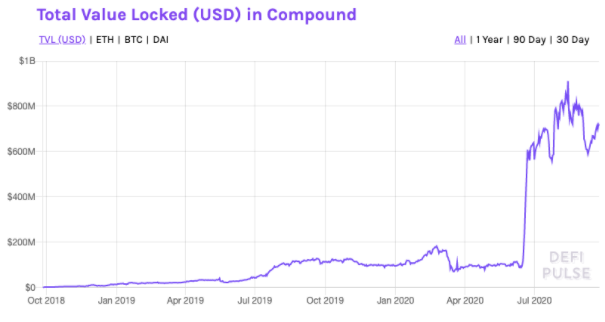
The concept behind Compound is relatively simple. Compound exists to allow users to stake collateral in the hopes of earning interest and also to allow users to borrow funds and pay interest over time.
Compound is an algorithmic, autonomous interest rate protocol built on the Ethereum network, acting as a decentralized bank. It’s also a protocol that other applications can tap into and build on. Unlike a regular bank, where deposited savings can’t be used while they’re earning interest, Compound users can spend the money earned by their savings while the assets are still earning savings.
Users contribute various crypto assets to the liquidity pool and earn compound interest, with rates programmatically altered based on supply and demand. Below are the tokens users can currently lend or borrow, as well as the annualized percentage yield (APY), or interest, for doing so.
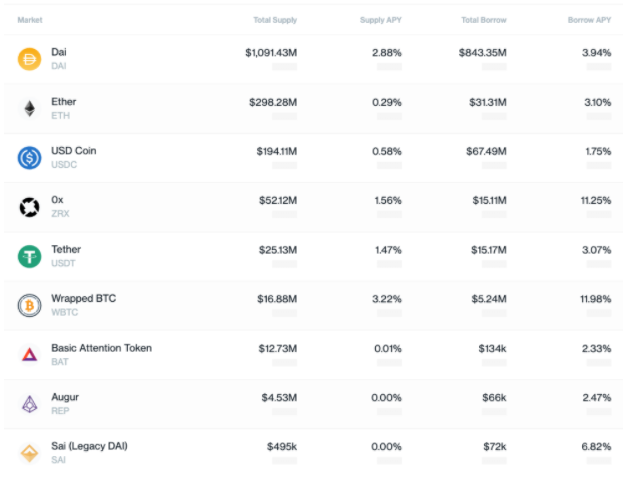
Users can stake ETH or other ERC20 tokens, like the stablecoin USDC. The platform shows the balance of staked assets as cTokens. Users can borrow 50-75% of the value of their cToken balance. For example, a user can stake $100 in Tether (USDT) and receive an equivalent amount of cTokens, shown as cUSDT.
Their cTokens will earn an interest rate based on the supply and demand on the platform, and users can also borrow $50-$75 for their cUSDT in another currency, like the stablecoin True USD. However, where there’s reward, there’s risk. If the value of a user’s collateral drops too low, the collateral may be liquidated. Even stablecoins can be susceptible to flash crashes at times, opening up users to a degree of risk — there’s also the possibility of a bug in the code for the protocol itself.
Interestingly, several Dapps have been built on Compound. One example is Staked, a robo-advisory service aimed at helping users maximize the interest they earn. Compound is also partnered or associated with various other projects in the space. While Compound is a noncustodial solution, users can choose to secure their funds with custody services from Coinbase, BitGo, or Anchorage.
Governance
Decisions on the direction of the project are made by users who hold COMP tokens, the governance token for Compound. Interest rate and liquidity caps as well as fees can be determined by voting, as can any other feature of the platform. The amount of COMP gained is related to the amount of interest being paid out on the platform. Users can use the token to delegate voting rights to the address of their choice, including to third-parties such as known DeFi experts.
Anyone with 1% of COMP delegated to their address can then write proposals, which are executable code rather than written suggestions. Proposals are voted on for three days and then are executed if a majority vote is secured.
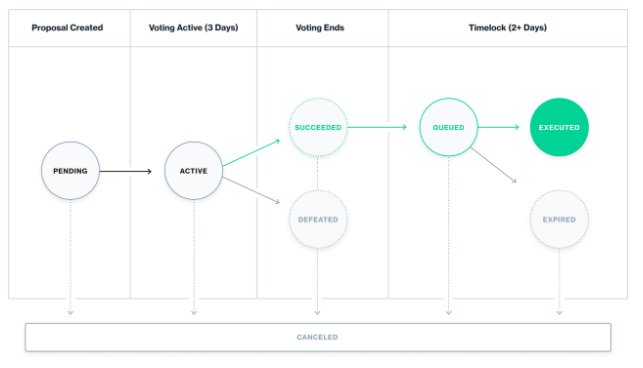
Source: Compound
COMP token was listed on Coinbase on June 25, 2020, leading to a sharp spike in value.
It’s worth noting that Compound is not fully decentralized, and this is a potential point of weakness for the entire project. In April, SpankChain CEO Ameen Soleimani discovered that $161 million worth of COMP tokens were locked in smart contracts under a centralized administrator. However, the project team publicly agreed with the assessment that this constituted centrality and are currently implementing a plan to fully decentralize the project over time.
Soleimani has since updated his post to confirm that the Compound team had fixed the problem:
They have transferred full control of their governance to the COMP token holders, with a minimum 2-day grace period before any accepted protocol changes are implemented. The admin capabilities, now firmly in the hands of the COMP token holder community, no longer represent a centralized point of failure for the Compound protocol.
However, the issue highlights that the term “decentralized” is not always as cut and dried as it seems, and there may be centrality issues in any of the DeFi protocols that have yet to be addressed.
Yield farming
Users can manipulate the system in such a way that their APY is over 100%, meaning they’re effectively being paid to take out a loan. This is known as yield farming. The Curve Finance exchange has seen massive growth in recent months due to the rise of yield farming, with yield farmers taking to the exchange to capitalize on high interest yields.
Yield farmers could, for example, stake USDC, borrow 75% USDT, and then lend their borrowed USDT for a net profit in COMP tokens. Yield farming typically involves leveraging the staked and borrowed assets for maximum yields. The practice of leveraging assets and then lending them out, or borrowing leveraged assets, is reminiscent of the 2008 banking crisis, during which the trade of leveraged credit-default swaps led to an economic bubble and subsequent collapse.
In DeFi, yield farming with 100% returns is likely unsustainable, leading many to speculate that DeFi is in a bubble. However, while many people use COMP for speculative purposes, the fundamentals behind the project are undeniable. The platform serves as a functional lending platform with an increasingly decentralized leadership.
Funding
Compound secured $25 million in Series A funding from az16 after receiving $8.2 million in seed funding from az16, Bain Capital Ventures, Polychain Capital, Coinbase, Danhua Capital, and Abstract Ventures.
Kyber Network
Kyber Network enables cryptocurrency transactions between various platforms and ecosystems, such as Enjin, MEW, Easwap, KyberSwap, and imToken.
The network can perform token swaps and convert them to a crypto preferred by the user, helping to solve the issue of interoperability. This has use cases for ecommerce, wallet solutions, exchanges, and DeFi Dapps and protocols.
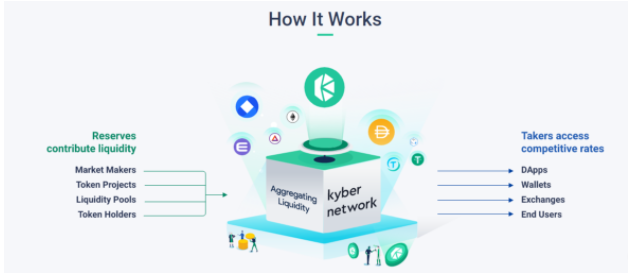
Source: Kyber Network
Dapps can enable people to use their platforms and services with tokens other than the native token, making Dapps far more accessible to the public, as many Dapps currently require users to hold the native token.

Source: Kyber Network
Users store their assets on-chain. Much like a bank, users can contribute idle assets to the liquidity pool. Tokens in the pool are available for anyone across any connected platform to use, and Kyber Network users earn a spread from every transaction made using tokens in the pool.
Using the pool, instant transaction settlement is possible, solving the issue of slow transaction speeds on congested blockchains and making crypto more viable as a means of purchasing or transacting.
Governance
Governance will be handled through staking via the Katalyst update. On Kyber Network, governance deals with the fee model, currency distribution, and other major decisions regarding the direction of the project.
Kyber Network has partnered with StakeWithUS, a blockchain firm that provides staking tokens and services. KNC token holders will be able to delegate tokens and votes to ATLAS, a staking pool operated by StakeWithUS, once the Katalyst update is live. Like most DeFi governance tokens, KNC is issued on the Ethereum network as an ERC-20 token.
Funding
Kyber Network has received $52 million in funding over three rounds. ParaFi, a firm known for backing Coinbase and MakerDAO early on, invested based on the potential they saw in the upcoming Katalyst update.
Other backers include Hyperchain Capital, Pantera, Fenbushi Capital, Kenetic Capital, FBG, Danhua Capital, Hashed, and Signum Capital.
Synthetix
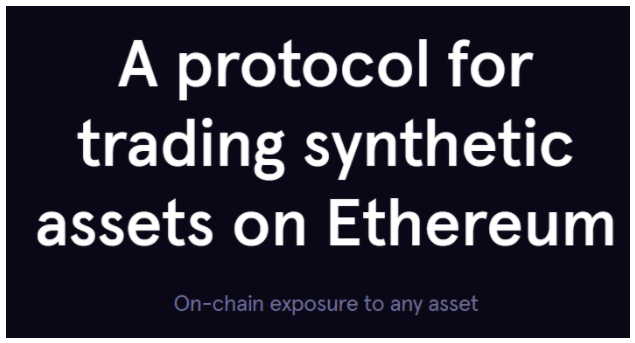
Source: Synthetix
Synthetix is a crypto exchange built on Ethereum. The exchange allows margin trading and is built in a decentralized manner, which appeals to many among the community. Synthetix users can gain exposure to Bitcoin and the U.S. dollar by speculating on price fluctuations, and the platform is working on incorporating TESLA stock and AAPL as well.
Synthetix users can create assets to represent stocks and shares on the network and exchange them for crypto. The platform uses two tokens: SNX and synthetic assets (sUSD).
SNX
The SNX token allows users to mint synthetic assets (Synths) by staking SNX as collateral. SNX can be staked as collateral to create any asset (making this project distinct from the Maker network. Oracles provide outside info on fiat currencies, and Synthetix aims to include stock market information soon.
SNX has an inflationary monetary system; 750% collateralization is required for synth assets, and staking this much SNX per synth makes SNX increasingly rare. This has multiple use cases, perhaps the greatest being easy access to stock market trading with lower fees.
Synthetix is partnered with Chainlink in order to establish decentralized oracles on the network.
Governance
Governance is partially available through SNX tokens. However, while users can vote on governance issues, cSynthetix is not fully decentralized at the moment. As with Compound, the team has announced that decentralization is in progress.
The basic protocol design, incentive parameter settings, and system development are presently governed by the Synthetix foundation. Although the foundation initially made this tradeoff between centralisation and speed of development, it is committed to further decentralising key decision-making processes in the system. Steps in this direction are being taken by the development of community-driven governance and development methodologies.
Once the platform has fully decentralized, it may be a top contender in the world of decentralized asset exchange.
Funding
While a16z never announced an investment, there are 374,111 SNX tokens in the a16z address worth over $28 million at the time of purchase. Framework also invested $3 million in the network.
DeFi and Ethereum
These DeFi protocols are not without flaws and risks attached. Lack of decentralization weakens the use case for the time being, as does involvement in the extreme speculation surrounding yield-farming. However, their long-term potential is undeniable, and their connection to the Ethereum project is likely positive for Ethereum fundamentals.A note to bear in mind is that Eth 2.0 staking might reduce the cost of DeFi transactions as well as the speed. As such, the success of Ethereum and DeFi is intrinsically linked. DeFi is the most concrete evidence of a real-world use case for Ethereum beyond speculative trading, and the upcoming Ethereum update may yet propel DeFi to even greater heights.



